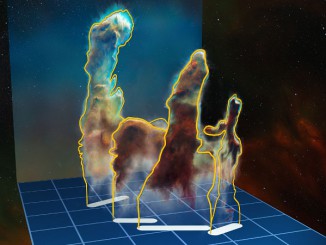
Perched on top of Cerro Armazones in the Atacama Desert of northern Chile, the E-ELT will have a giant main mirror 39 metres in diameter. It is one of the biggest global science collaborations in history and includes an £88 million investment by the UK government. UK industry has already won over £10 million worth of contracts from the E-ELT in advance of HARMONI and that figure is expected to at least match the UK government’s investment by the time construction is complete.
The telescope will enable scientists to see more distant objects than previously possible, allowing them to understand younger structures in our night sky than ever before — helping improve our understanding of the Universe, the effects of dark matter and energy, and planets outside of our solar system.
In its early days, the E-ELT will be equipped with three scientific instruments; two first light instruments, a camera (MICADO) and a spectrograph (HARMONI), followed soon after by the mid-infrared instrument (METIS).
The HARMONI instrument will observe an astronomical object in three dimensions simultaneously, with spatial information in two dimensions and wavelength in the third. It is led by Professor Niranjan Thatte from the University of Oxford in collaboration with the Science and Technology Facilities Councils’s UK Astronomy Technology Centre, Edinburgh.
“We are privileged to be leading the design and construction of the first spectrograph for the E-ELT,” said Professor Thatte. “It will revolutionise observational astronomy through the 2020s and beyond. By studying the light from galaxies, distant and nearby, in great detail, we hope to unravel the physical processes that have shaped the cosmos throughout its history.”
The spectrograph splits the light from the object in the sky into its component wavelengths or colours. Astronomers can use these ‘spectra’ to determine far more than images alone ever can: they reveal the motion, temperature and chemical composition of structures imaged using the telescope.
The HARMONI instrument will be especially powerful in that it combines imaging and spectroscopy using a technique called ‘integral field spectroscopy’. This enables spectra of many positions in a galaxy (for instance) to be measured simultaneously, producing a galaxy map in 3D i-ncluding spatial information in two dimensions and wavelength in the third. The wavelength dimension tells astronomers the distribution of velocities within the image.
HARMONI will be a versatile instrument, providing a range of scales, resolving power, field of view and wavelength ranges — for instance, providing high spectral resolution for bright objects or high sensitivity for dim, distant objects.
“HARMONI has been designed to be a workhorse instrument,” explains Professor Thatte. “It will be utilised by all the early science being carried out at the E-ELT. That’s why we designed it to be easy to calibrate and operate, providing the E-ELT with a ‘point and shoot’ spectroscopic capability.”
The device will be used across all of the E-ELT’s experiments in early years, from imaging planets to probing black holes. It will be used to directly observe planets and stars, providing early spectral analysis of exoplanets; to resolve individual stars, quantify the different types, their properties and their place in galaxy formation.
Colin Cunningham, Director of the UK Programme for the E-ELT, based at STFC’s UK ATC, said: “It is very gratifying to see the UK-led HARMONI instrument for the E-ELT moving into its design and construction phase. It will provide a tremendous opportunity for UK astronomers to get early access to the outstanding science possible with the world’s largest optical and infrared telescope. UK industry also has an opportunity to benefit”.
Southampton-based company Selex ES which develops and manufactures sensors and systems, benefits from an ongoing relationship with STFC and ESO. A Selex ES spokesperson said: “We are pleased to work with the astronomy community to support their ground breaking scientific advances. The opportunity to provide detectors for a prestigious project such as E-ELT’s HARMONI will further develop this relationship and exploit our technology for large format detectors”.
As well as project leadership, the UK will also deliver significant sub-systems. The University of Oxford will deliver the crucial User Interface software and simulation tools and, with help from STFC’s RAL Space, the four spectrographs. The UK ATC will host the system integration and test and deliver the main support structure and cryostat as well as wavefront sensing subsystems for the adaptive optics, in conjunction with Durham University.
Under the contract, the UK will receive just less than 20m Euros from ESO to cover the purchase of components by the consortium and STFC will contribute around £7M to support the required staff effort at Oxford and Edinburgh in the first four years.
Project Manager for HARMONI, UK ATC’s Ian Bryson said: “To enable HARMONI to deliver great science, for the next 9 years the combined engineering and science team face a daunting challenge to produce this unique state of the art capability. The instrument is not just about high precision optics – all engineering disciplines are equally critical and we are fortunate in having a highly skilled team from across the consortium with the ingenuity, expertise and enthusiasm to make HARMONI a success.”
Today’s agreement was signed by Professor Grahame Blair, Executive Director, Programmes, Science and Technology Facilities Council, on behalf of the consortium, and Professor Tim de Zeeuw, ESO Director General, at a ceremony at the University of Oxford, United Kingdom, on 22 September 2015. Professor Patrick Roche, President of ESO Council and Professor Niranjan Thatte, Principal Investigator for HARMONI, were also in attendance.
The project includes contributions from Centre de Recherche Astrophysique de Lyon and Laboratoire d’Astrophysique de Marseille, both in France, along with Instituto de Astrofísica de Canarias and Centro de Astrobiologia, Instituto Nacional de Tecnica Aeroespacial, both in Spain.



